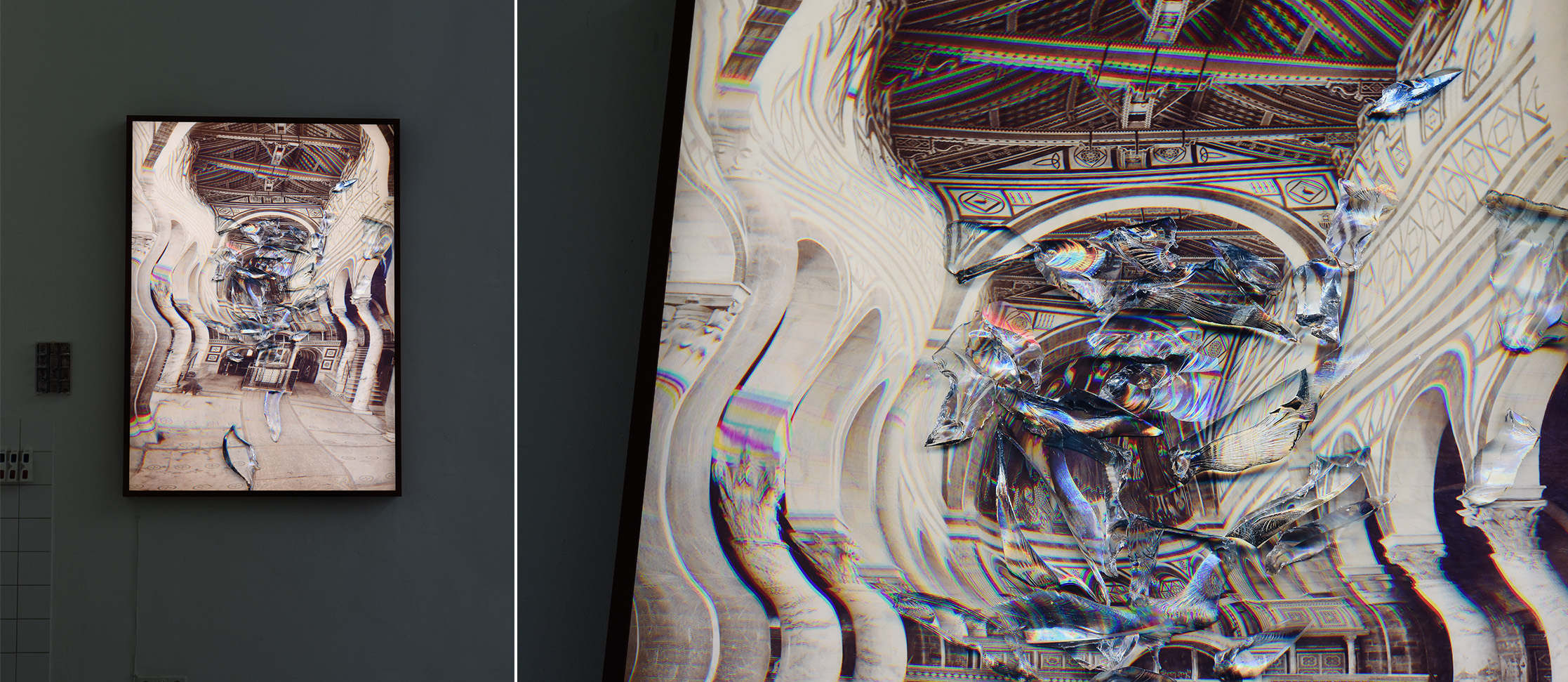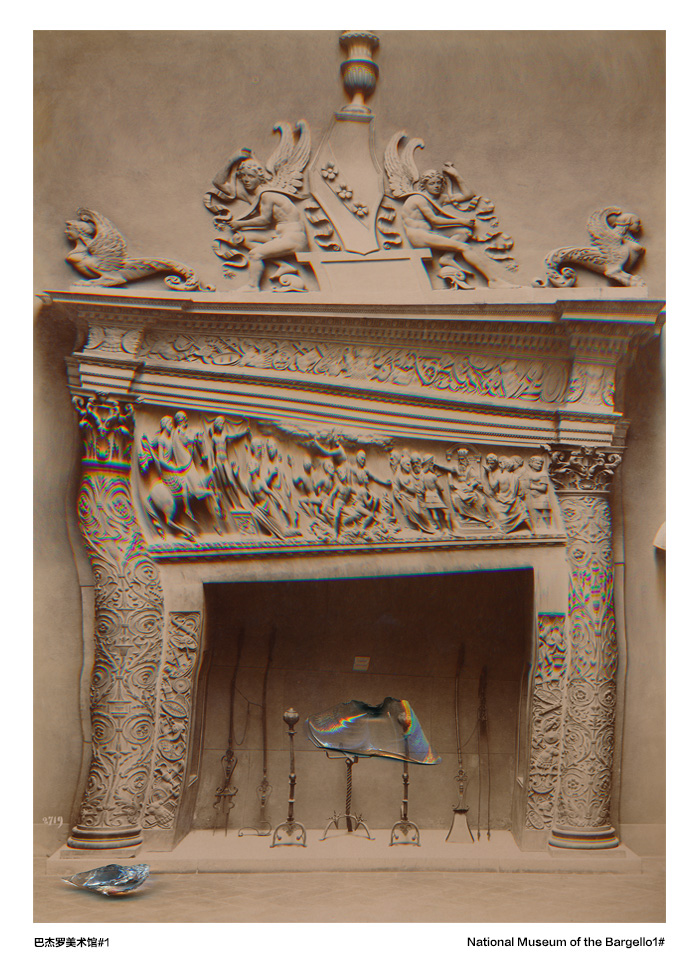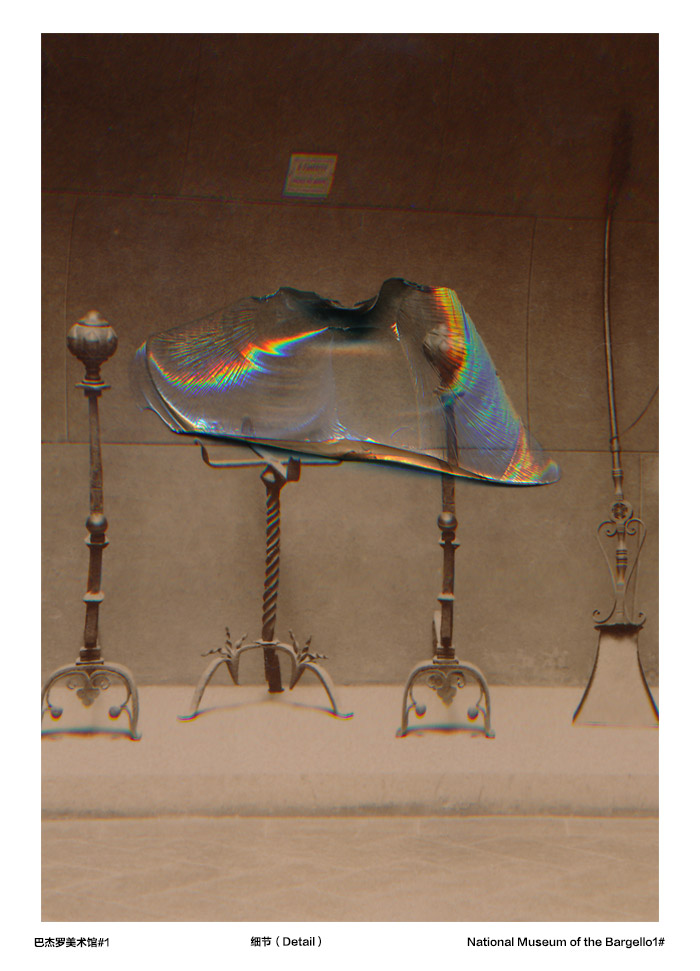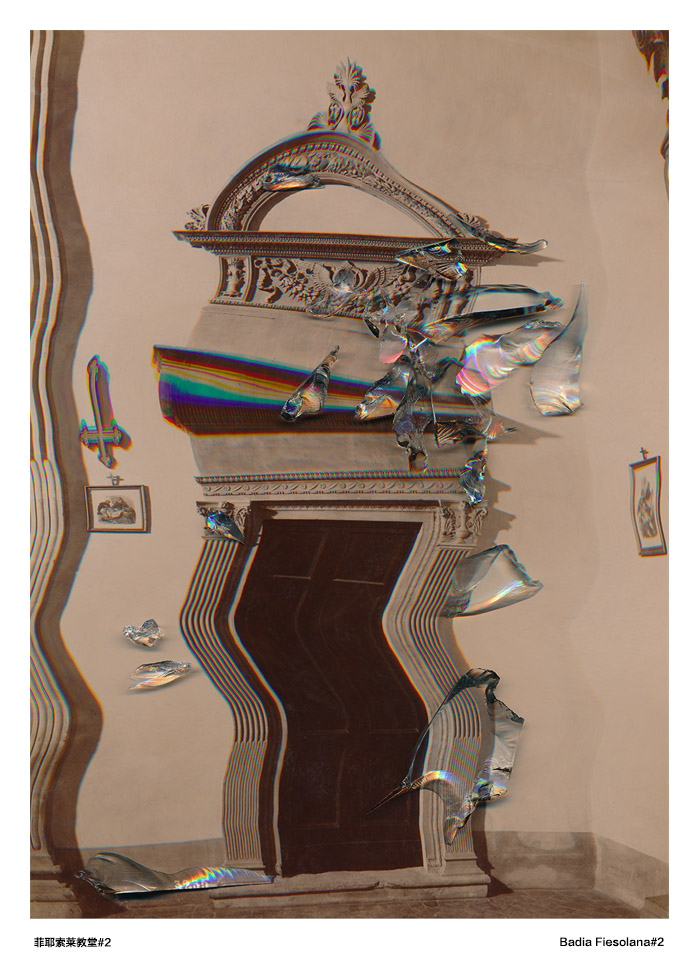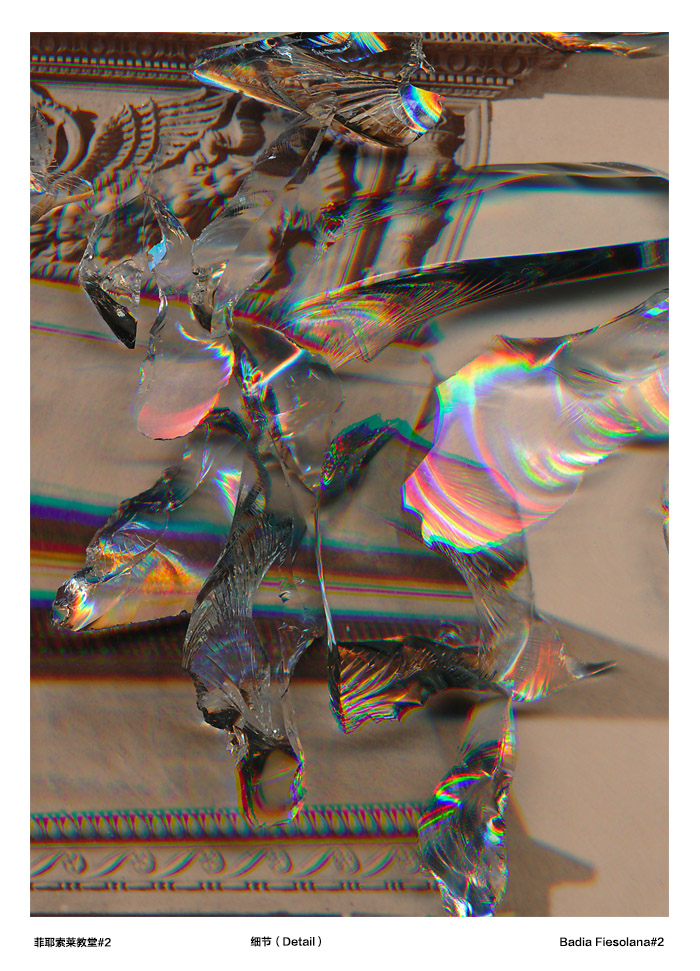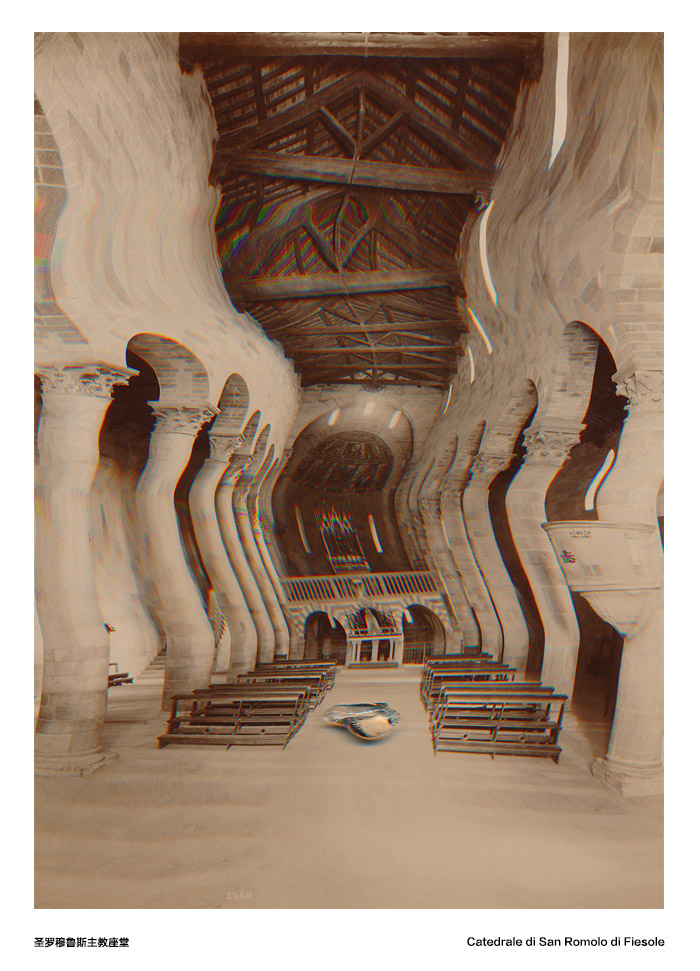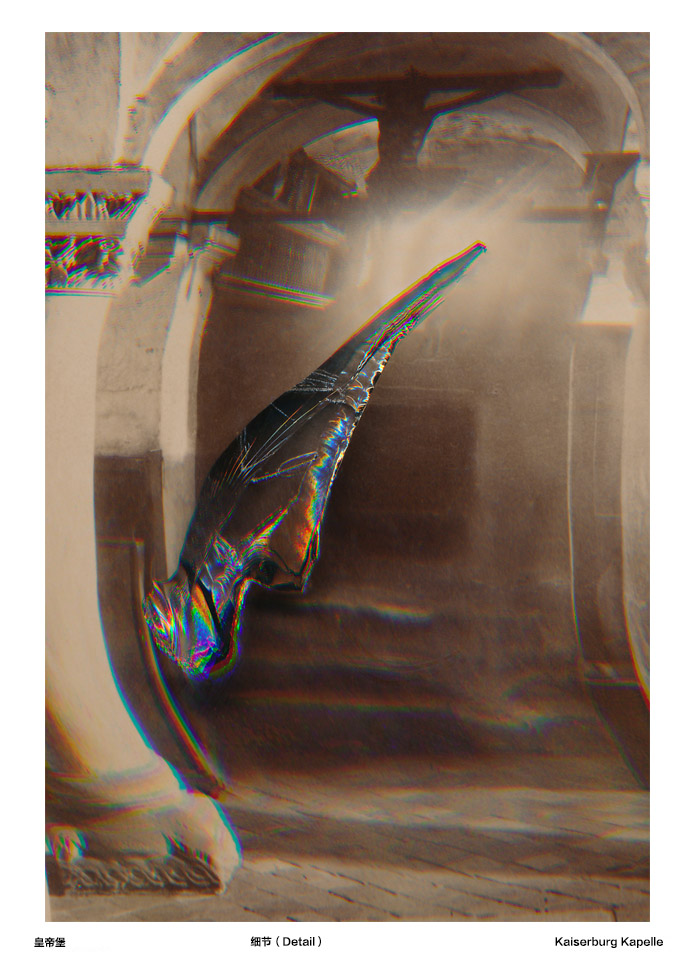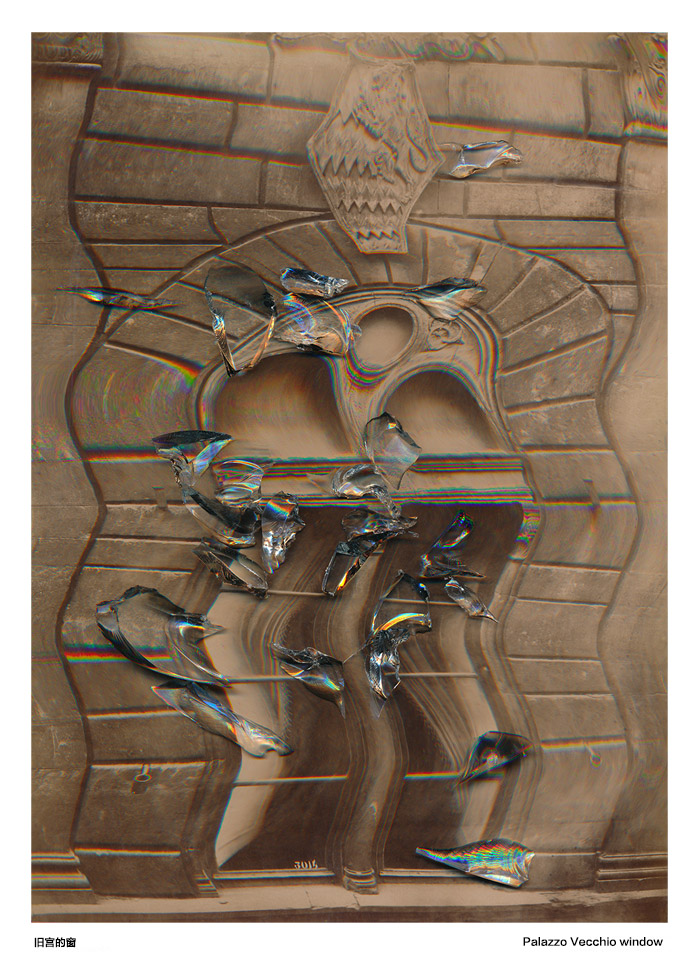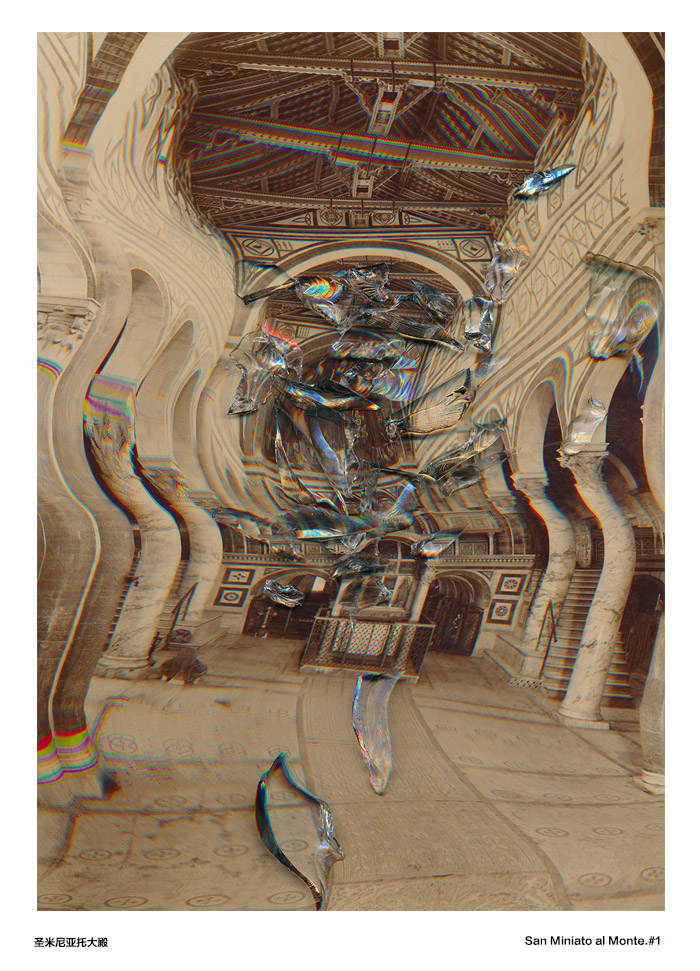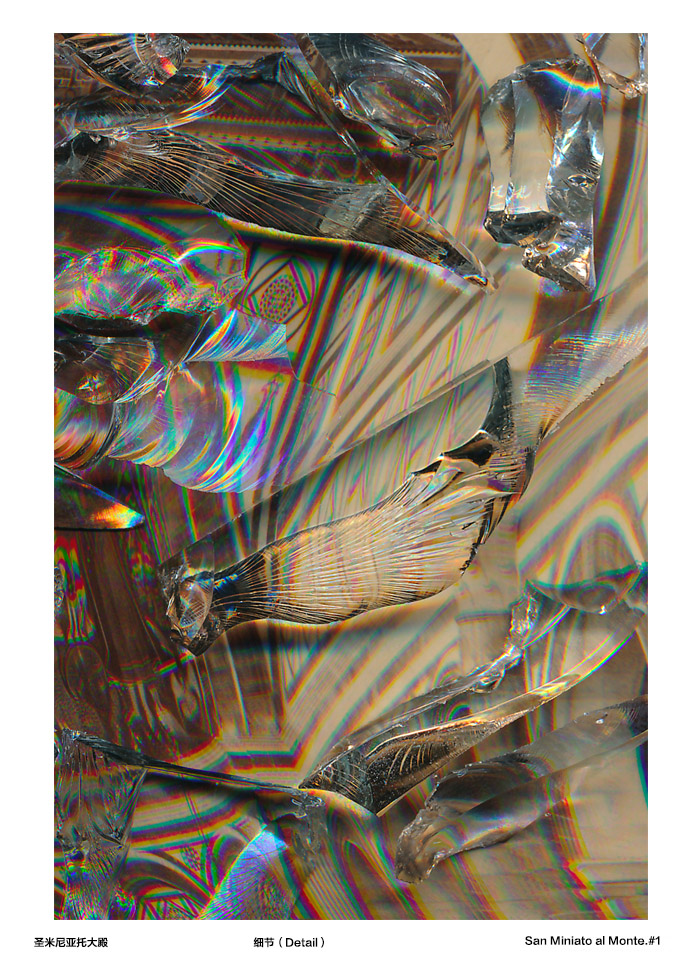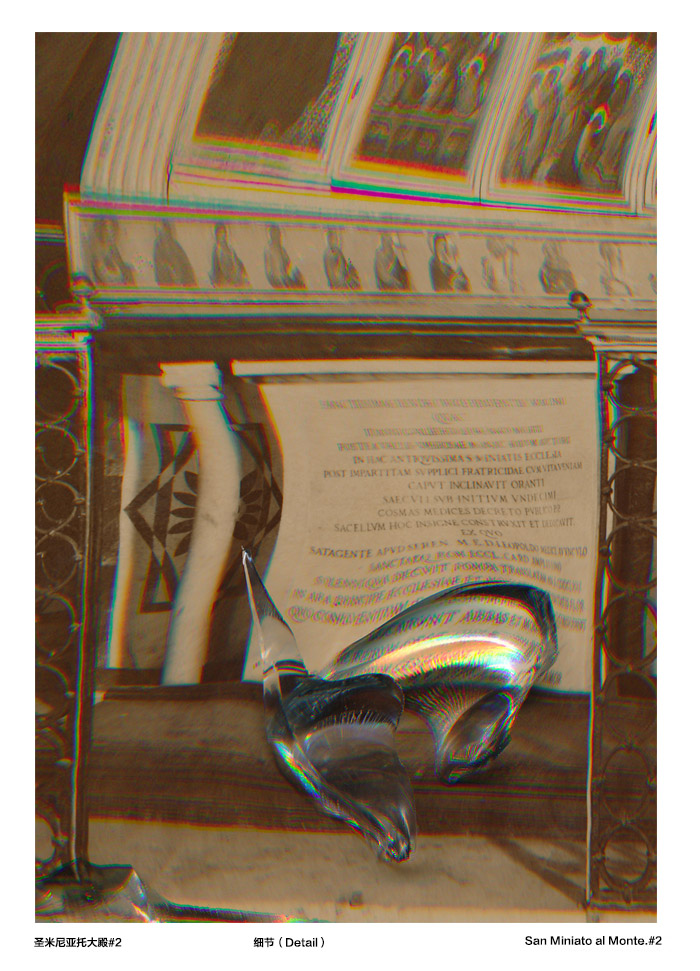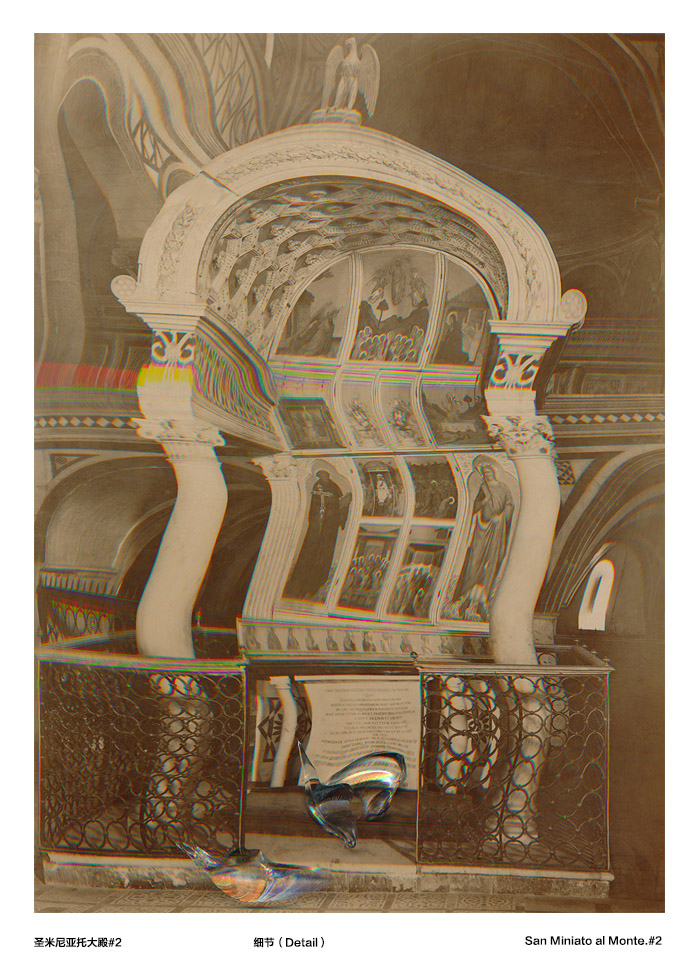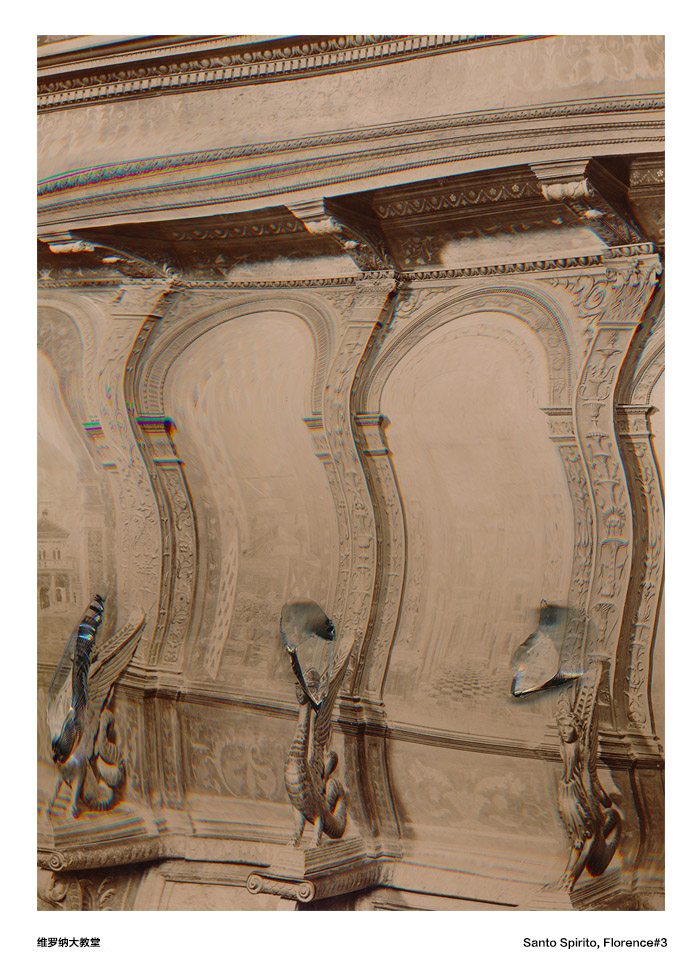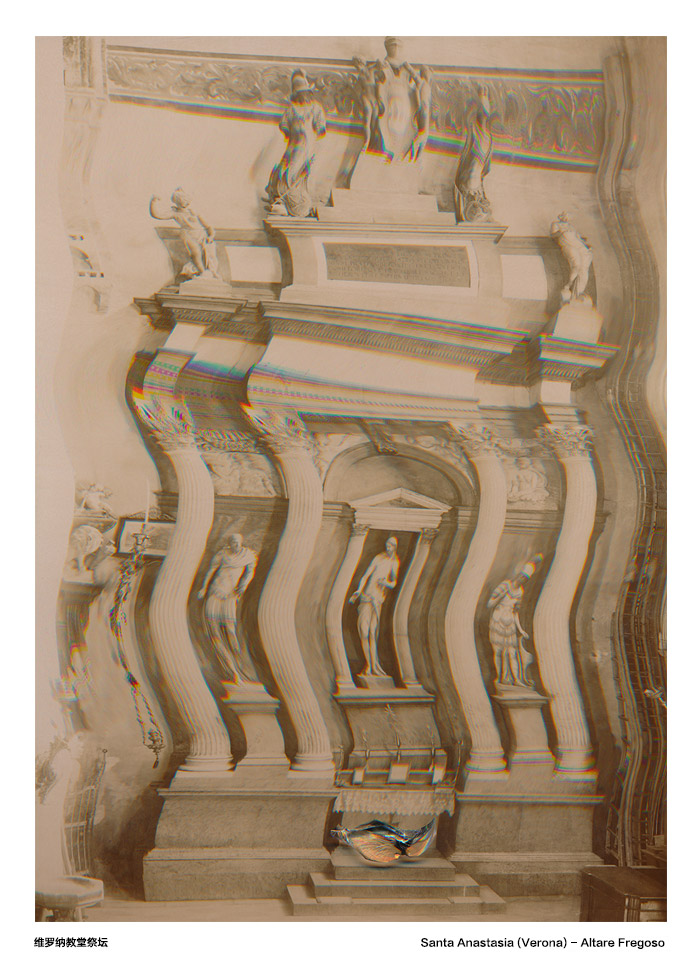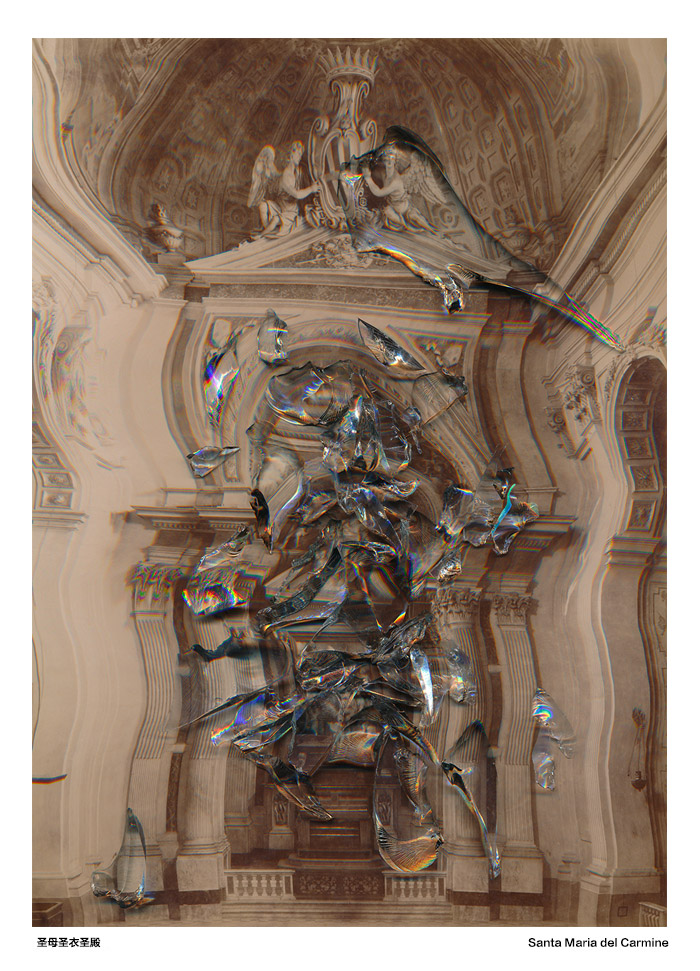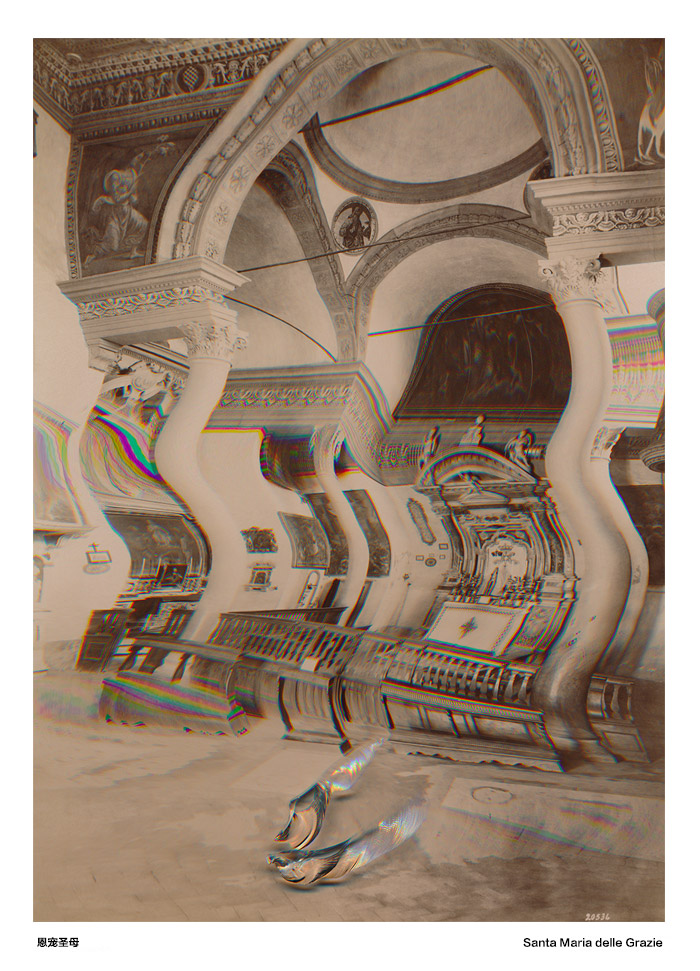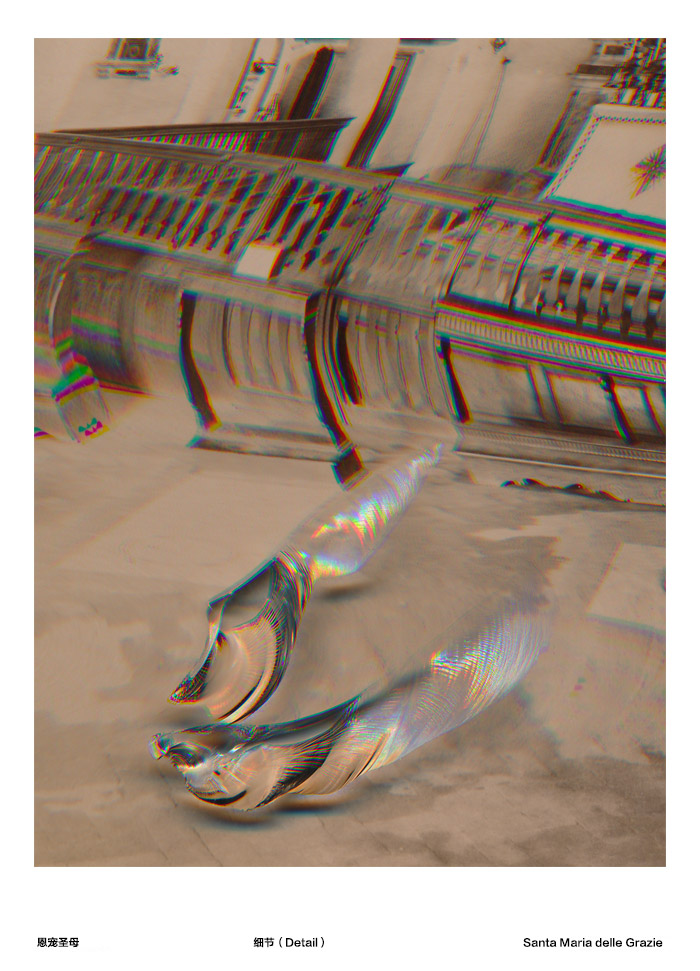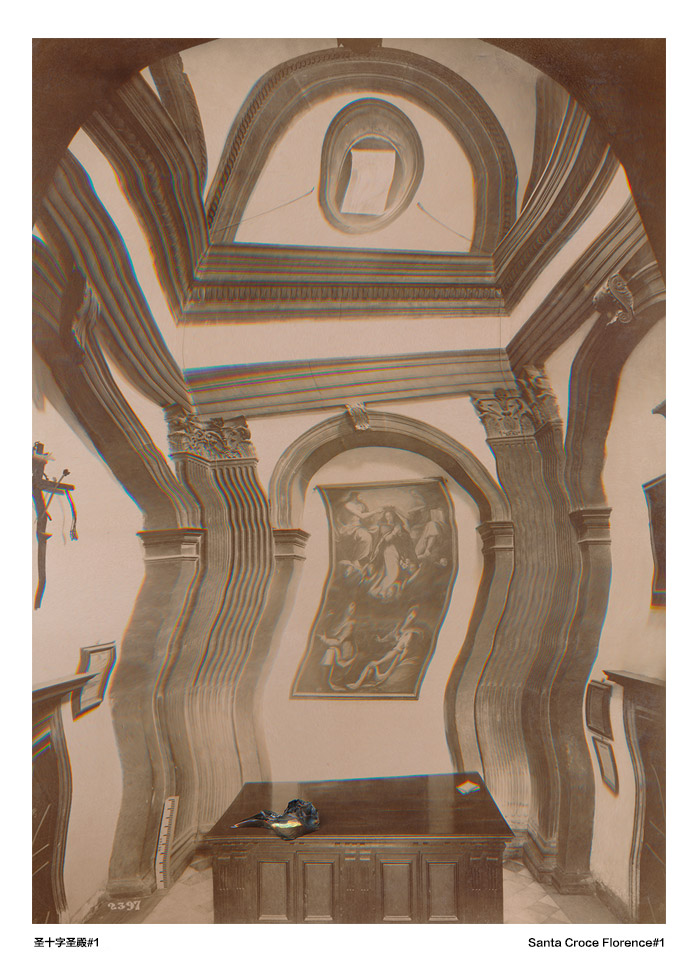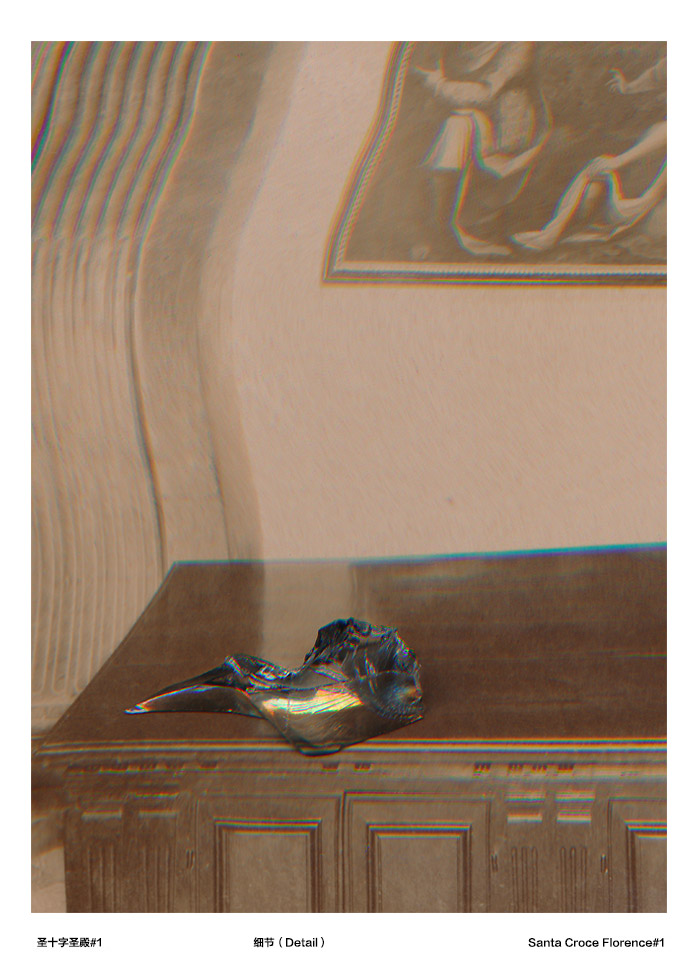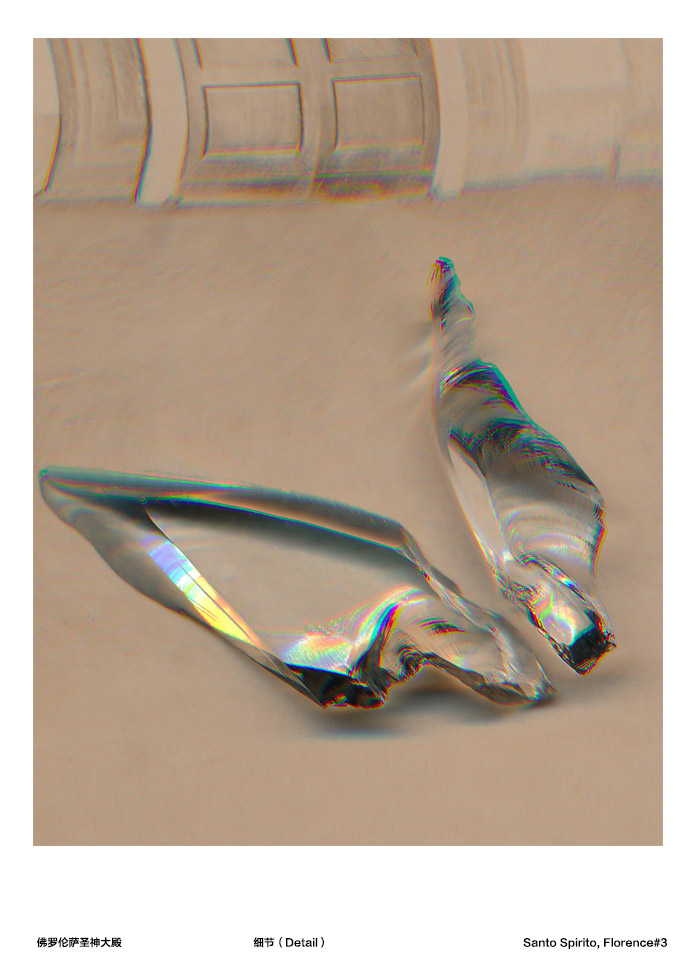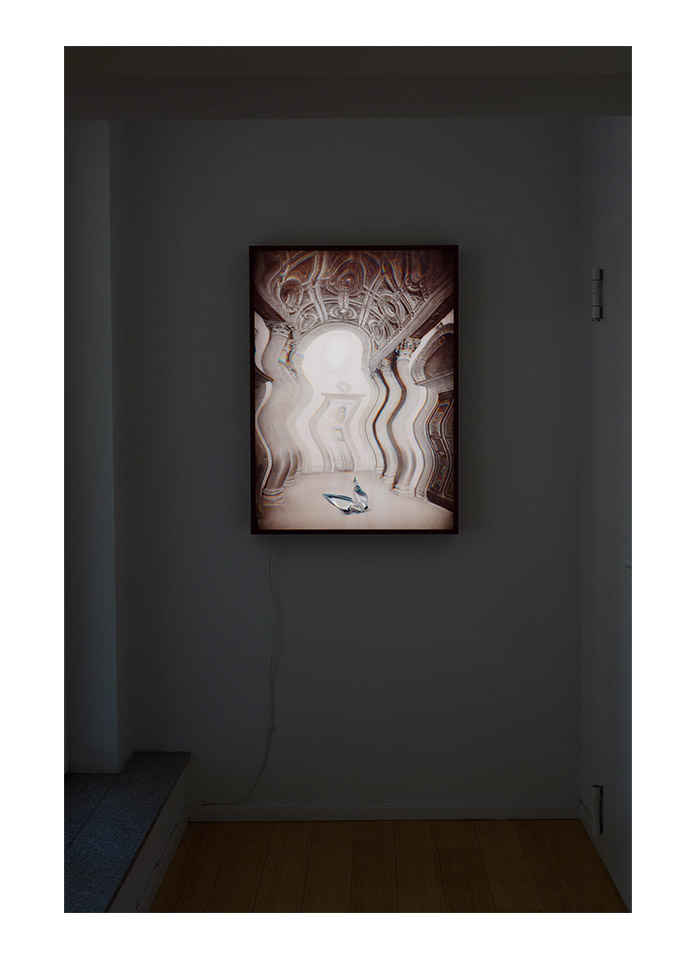Architectonics 2.0
我相信在时光穿梭的二维与三维的分野间,必藏有不可名状的新世界,如两个相邻彼岸,被一条深河隔断,相比探索能可见的陆地世界,这条给予两岸生机的深河更让人有想去探究的冲动。—— 高郁韬
《建筑学2.0》的创作素材来源于两个部分,十九世纪八十年代的建筑摄影照片和玻璃。素材之一源于自己收藏的德国摄影师Alinari在十九世纪八十年代所拍摄的意大利建筑系列。其风格多样,包含了哥特式,罗马式,和巴洛克式的建筑。在当时的宗教建筑设计中,光和空间的关系以及营造神秘感乃至神圣感得益于对玻璃窗户的广泛运用。我把数块方形的大玻璃处理成不规则的玻璃碎块。其结果是不可预测的,唯有极少的时候,方能获得心仪的带有翅膀纹样的小块玻璃,它成为这个系列视觉上的神秘焦点。
我把收藏的照片以及精心挑选出来的小块玻璃,放在扫描仪器上同时扫描,随着扫描仪的启动,扫描仪器上的玻璃与照片也跟随着光缓慢移动。扫描仪的光,很好的呈现了小块玻璃的影子,赋予了它与老照片之间新的空间关系。不仅如此,因为从上到下拖拽照片所偶然产生的类似红移现象的彩色光带,结合红蓝3D眼镜,可以让观众感受到更深的空间感与神秘感。这并不是后期软件(Photoshop)处理的结果。仅仅是通过扫描这一道工序,当扫描仪启动时,扫描仪上的光宛如一双神秘之手,把三维世界的立体玻璃送进了二维的世界中。
《佛罗伦萨卡尔米内圣母大殿#1》(“Santo Spirito, Florence#1”)中假用巴洛克式建筑所呈现的不规则,倾斜的视觉体验,正是创作者希望能给观众营造的一个致幻的宏大世界。翅膀形状的玻璃与伦勃朗的《圣家族与天使》(Holy family with angels)中的天使有着类似的含义。两者都是相对于画面主体的外来物,并且象征着新生。进一步来说,玻璃-三维物体“介入”了二维的画面,这个过程将新生赋予给古老的照片。
伴随着我迈进佛罗伦萨的圣米尼亚托大殿(San Miniato al Monte)的第一步,宏大的管风琴演奏在那一刻响起。庄严神圣的音乐将时间定格,我仿佛听到了一幅神秘的中世纪油画。这就是我所追求的各种艺术表现形式在到达到最顶层之后,不同形式之间所能产生的交融与共鸣。在《建筑学2.0》的作品中,《圣米尼亚托大殿》(San Miniato al Monte),我希望观众能体会到潜藏在画面中的乐音。
《建筑学2.0》侧重于建立新的联系,在二维与三维之间,在观者与作品之间,在现实与神秘幻象之间。对图像细节的深入挖掘为这种努力提供了可能性,如同泰戈尔诗句:“神的巨大的威权是在柔和的微颸里,而不在狂风暴雨之中。” 那将是从二维与三维的分野间的河流里获得的事物。
《建筑学2.0》命名过程借用了互联网上的专有名词,如Web 2.0,它强调与人与人之间的互动,《建筑学2.0》中的2.0,所强调的不仅仅是是三维物体对二维空间的一次“介入”,我更希望在未来把这次作品中的小玻璃通过3D扫描放大后制作成透明材质的装置作品,安置在真实的场景,最终完成一次二维到三维的“入侵”。
Architectonics 2.0
In the division of the two-dimensional and the three-dimensional space, where the time flows, I believe, there must be an indescribable new world. It likes the a adjacent land is cut off by a deep river. You see both side of banks clearly. But the only deep river, who supplies the nutrition to both banks, stimulates your curiosity to explore it.
- Gao Yu Tao
The source materials of „Architectural 2.0„ are two parts. The religious architectural photographs from 1880s and glasses. One of the sources are my collection of Italien architectural photographs by German Photographer Alinari. The style is varied, including gothic, romanesque and baroque architecture.
At that time, the religious architecture were benefited by the extensively use of glass windows. It created the relationship between light and space, brought mysterious and sacred feeling. I broke several large squared glasses into irregular forms. The result is unpredictable. Very seldom, I can achieve the admired forms with patterns of wings. The wings patterned glasses is the mysterious visual focus of the series.
I put a photo and carefully selected small pieces of glass on the scanner. As scanning starts, I moved the photo and glass with the scan light slowly. The light captured the shadow of glass and gave it a new spatial relationship with the photographs. What’s more, by dragging photos, it accidentally generated a red blue edge of image. When the audience ware the 3D glasses, they can see image with depth and space. This is not the result of postproduction (Photoshop). It is achieved by scanning. The scanning brought the three-dimensional glass into the two-dimensional world.
The irregular, sloping inner line in“Santo Spirito, Florence # 1“ creates a hallucinatory experience to the audience. The wing-shaped glass has a similar meaning to Rembrandt’s Angel in „Holy Family with Angels“. Both glass and Angels are foreign intervening to subject. It symbolizes the newborn. The 3D glass, as object „intervenes“ in a two-dimensional picture, a process that gives the new life to old photographs.
When I stepped into Florence’s San Miniato al Monte, the magnificent organ started at that moment. Solemn sacred music freeze the moment. I „hear“ a mysterious medieval oil painting. This is what I am pursuing, different forms of arts reach a peak level and they begin blending and resonance. In „Architecture 2.0“, San Miniato al Monte, I hope the audience can appreciate the sounds that are hidden in the picture.
Architectonics 2.0 focuses on new connection between 2D and 3D, audience and works, reality and illusion. The excavation of the details offers the possibility to this direction. Like Tagore verse: „God’s great power is in the gentle breeze, not in the storm.“
That is from the deep river between the banks of 2D and 3D.
The name „Architectonics 2.0“ is borrowed from the Internet, such as Web 2.0, which emphasizes interaction between person to person. Architecture 2.0 emphasizes more than just 3D intervening into the 2D. I hope that in the future, the small glass in this work will be magnified by 3D scanning and made by a transparent material. I can place it into the real space, to complete a invasion of 2D to 3D.

